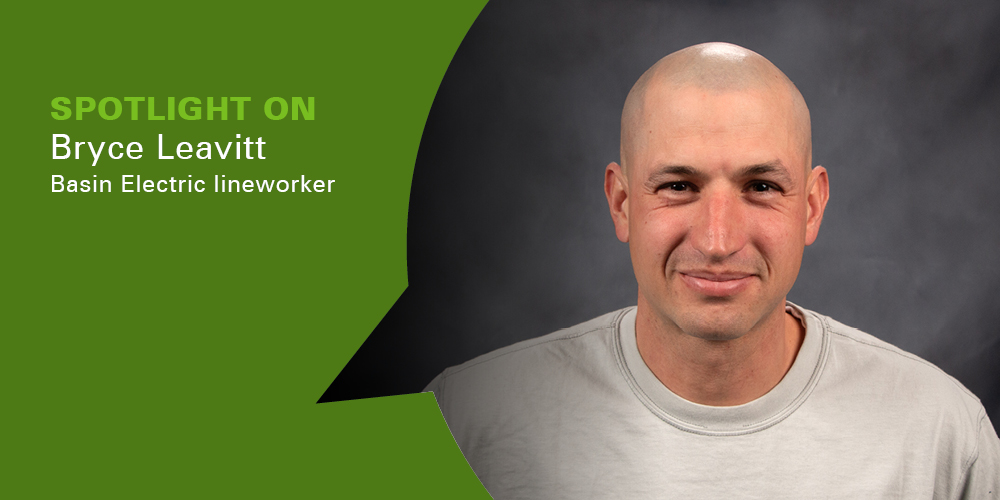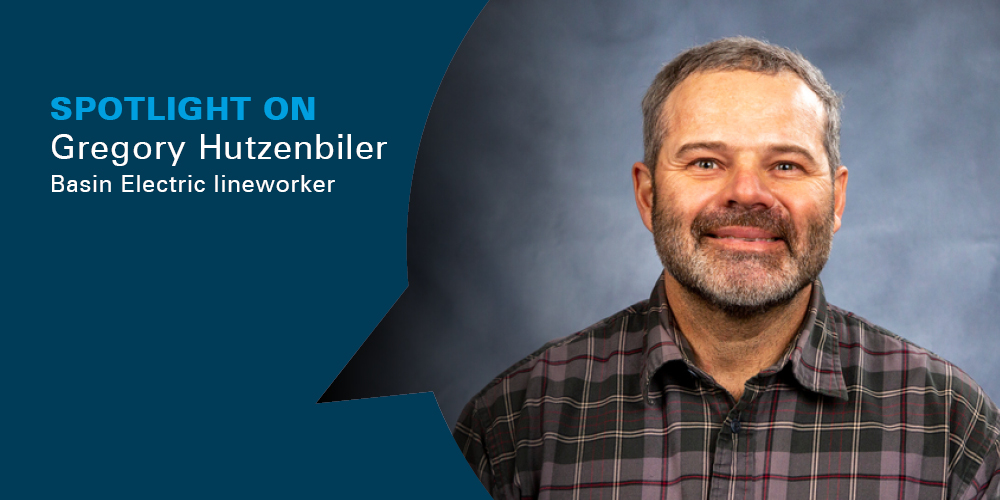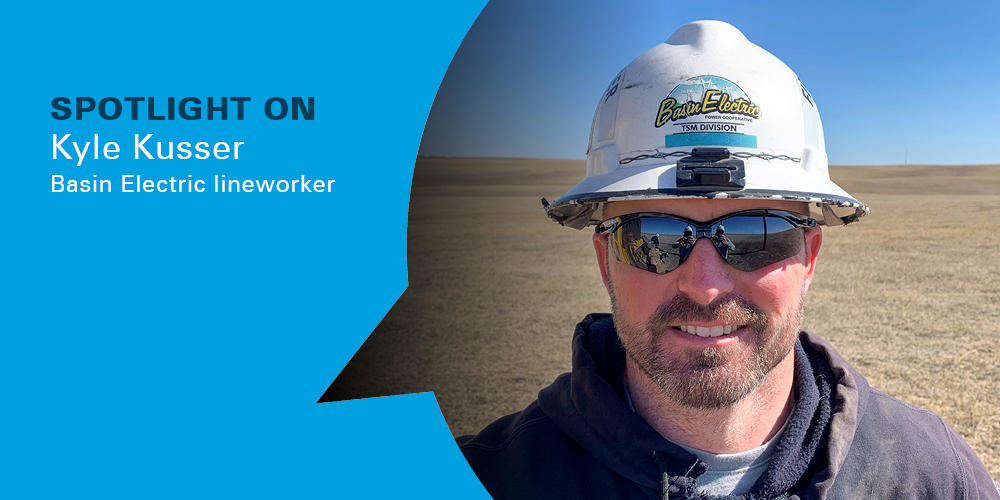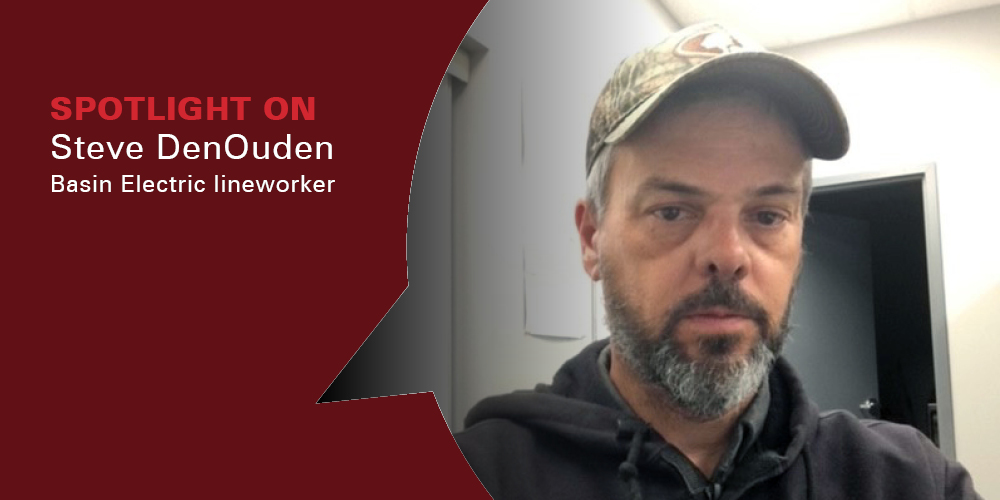- Products
- About
- Responsibility
- Environment
- News
- Contact us
- Careers
-
In honor of National Lineman Appreciation Day, we asked Basin Electric’s lineworkers to tell us the best parts and the craziest parts of their jobs. Here’s what they had to say.

The best part of my job is a two-part answer. First of all, I love being a lineman, and I am so happy I chose this career. I have met some amazing guys and have done things I never imagined. I have enjoyed working with customers to provide all of their power needs. Second, I am new to Basin Electric but I have enjoyed my time here and even further done things I never thought I would have an opportunity to do.
The only major storm I have been on was in June of 2017 when a tornado hit Bayard, Nebraska. We had help from all over the valley. NPPD (Nebraska Public Power District) and WAPA (Western Area Power Administration) worked on all of the transmission lines while the rest of the municipalities worked on the distribution side. It took us five days to fully restore power to the whole town again. It was a lot of fun to work with a bunch of people to safely repower an entire town.

As a new member to the Basin TSM (Transmission System Maintenance) division, I would have to say that the most rewarding part of my job here is moving to a new community and being able to be a part of that community.
I have had to partake in many storm projects throughout my career. The one that stands out most in my mind was Hurricane Michael. This storm made landfall as a Category 5 hurricane and was the third most intense hurricane in U.S. history. Hurricane Michael made landfall near Panama City, Florida, on Oct. 10, 2018. It recorded winds as high as 160 mph and left 1.2 million homes without electricity.
We reported on Nov. 18 to help repair a major 230-kilovolt 34-mile line that went from Panama City to Apalachicola (substation Port St. Joe to Callaway). As we entered Florida, the extent of the damage was unbelievable. There were trees and houses laid completely flat as far as 100 miles inland. We were led to the ROW (right-of-way) by the National Guard and had to wait for extended periods while they used road graders and dozers to move debris (sometimes complete houses) off of roadways in order for us to be able to navigate through to the powerline. Then the work started.
I was part of a 10-company project for Duke Energy that involved 220 crew members and consisted of a wire and tower removal crew, four drilling crews, multiple framing and setting crews, one sky crane, one Blackhawk, two 2-MD500 helicopters, a wire stringing operation crew, multiple boat crews, and a matting/road building crew that implemented use of over 10,000 mats.
The major accomplishments during the project were:
Day 39 - 328 holes drilled and bases set
Day 43 - all pole tops framed and installed using the sky crane and Blackhawk
Day 64 - wire operations (that averaged one mile per day pulling and clipping) completed their final dead-end.
With grounds removed and aerial work completed, the line was turned over to Duke Energy. This project had no recordable injures and no environmental incidents. The amount of planning, preparation, coordination, and work that was completed in during this project was unbelievable, and I was fortunate to be a part of it.

The best part of my job is how much variety is in linework. My first foreman told me as soon as I think I know it all, have seen it all, or done it all, then it’s time to get out of linework.
Transmission lines, distribution lines, underground, substation – my favorite part of working at Basin Electric (which is best employer I have worked for) is Basin covers it all: generation, transmission, substations. As linemen, we patrol lines, find problems, and fix them. All of them – fences, towers, steel poles, wood poles, trees, climb, buckets, cranes, and conductors. Basin Electric has some of the best tools, equipment, and men I have been blessed to work with.
The most challenging storm I have worked on so far, I was working in Iowa for a summer. Mid-American Energy lost about five miles of wood H-frame 345-kilovolt horizontal bundled conductor transmission line. It was very hot and humid in July. Half the job was in tall corn fixing the damage and tensions of poles and conductors. Several pole tops were driven into soil one to two feet, and most large wood transmission poles snapped in half or at ground line. The hazards and conditions were extremely challenging. The general foreman for Par Electric was amazingly organized and a great communicator with plans and had roughly 75 line-hands on project. Thirteen days at 17 hours a day, we finally had line complete and re-energized.
I love the work and men involved with line work. There’s always someone new to meet or something new to learn. It’s an elite brotherhood. I compare it to my experience in the military working on the flight deck of an aircraft carrier.

Opportunities. The best part of my job is the wide array of different tasks that we, as linemen, are responsible to perform. Just when the day-to-day life at work starts to get a little stale, we have plenty of opportunities to switch it up completely. For example, one week we may just ride along the right-of-ways inspecting towers on ground patrol. The next week we might be on a tower with a hotstick in our hand repairing something on a high voltage line. We could have a shovel in our hands one day and hundreds of thousands of volts in our hands the next. There is always an opportunity to solve problems. And in that, there is always an opportunity to do it better and more efficient than you did it last time. The industry is always changing. So, we have constant opportunities to learn and enhance our knowledge as well as our skills as linemen.
The craziest storm I have ever worked in was actually when I was still on a construction crew. We were dispatched to Bowman, North Dakota, for the winter storm in February 2010.
At the time when that storm rolled in, my crew was working on a 230-kilovolt project west of Hot Springs in the southern Black Hills of South Dakota.
From our vantage point, it looked like a summer storm with thunderhead type clouds that stretch incredibly high into the sky. I remember leaving work that Saturday being told to pack a bag and prepare for cold weather because by Monday we were going to be heading north. Sure enough, the next day we all got called back to Rapid City, South Dakota, to start gathering tools and preparing trucks to go battle Mother Nature and her frigid fury. By Monday morning there was a convoy of red trucks heading north to team up with other line crews to help Slope Electric out of, what seemed to be, a complete devastation of their electrical grid.
As soon as trucks rolled in, snow-moving equipment was unloaded. Dozers, log skidders, loaders, buckets, blades, and blowers. We called all cars. Armed with some of the gnarliest equipment specialized for building transmission lines in the roughest of country, we stepped onto the field of battle, ready to butt heads with this arctic beast. The boys and I worked through the day and part of the night to open roads and accesses to the wreckage that laid in the fields and pastures so that first thing in the morning we could get our digger derricks and bucket trucks on site.
I’ll never forget that first day on site. Tire chains jingled as an army of trucks rolled out and scattered to start the restoration process with the storm still raging on. The job with which I was tasked was operating a commander digger derrick, digging holes through the frosty soil and planting new poles amidst the rubble of the fallen structures. The snow flew as the wind drove the temperatures below negative 60 degrees windchill. We worked as hard and as fast as we could with the only relief from the elements being in the cab for the time it took us to drive the trucks to the next structure, just to get out and do it all over again. This particular stretch of line happened to run in a direction so that the only place for me to set the truck up left me looking directly into the wind while I operated. I remember my eyelids freezing shut, and the layer upon layer of Carhartt and Under Armour being no match for the continuous blast of cold while working.
The first few days continued like this. The sun eventually came out and we pushed onward through incredible amounts of snow and ice. In the end, we would have been there for six straight weeks. The exact number of poles replaced in our time there has left my memory, but I know the count was in the several thousands. Not to mention the seemingly countless miles of wire either repaired or replaced.
This storm was one of the best experiences of my career. Our line crews received no less than rockstar treatment while we fought to restore power. There are many stories that I could share from this one storm job alone, however it would take a very long time to unpack them all. But there is no question in my mind that the craziest storm I have ever worked was the Bowman ice storm of 2010.

The best part of my job is working outside.
The most damage to our system would have been the Bowdle, South Dakota, 500-kilovolt line. But as far as crazy conditions and weather, I would say going out on outages and seeing a funnel cloud in the distance and driving towards it. Seeing cross arms tearing off just after we had energized the line during the 2005 ice storm was bad.
Dakota Gasification Company
Headquarters:
1717 East Interstate Avenue | Bismarck, ND 58503-0564 USA
701.223.0441 | 1.800.242.2372
Great Plains Synfuels Plant
420 County Road 26
Beulah, ND 58523-9400 USA
701-873-2100
A subsidiary of:
Basin Electric wants all interested and qualified candidates to apply for employment opportunities. If you are an applicant with a disability who is unable to use our online tools to search and apply for jobs, or who needs other assistance or accommodations, please contact us at 701-223-0441. Please indicate the specifics of the assistance needed or provide your contact information, and a Basin Electric Human Resources representative will contact you. Basin Electric is an Equal Employment Opportunity Employer regarding race, color, religion, sex, sexual orientation, gender identity, national origin, disability, and veterans status.